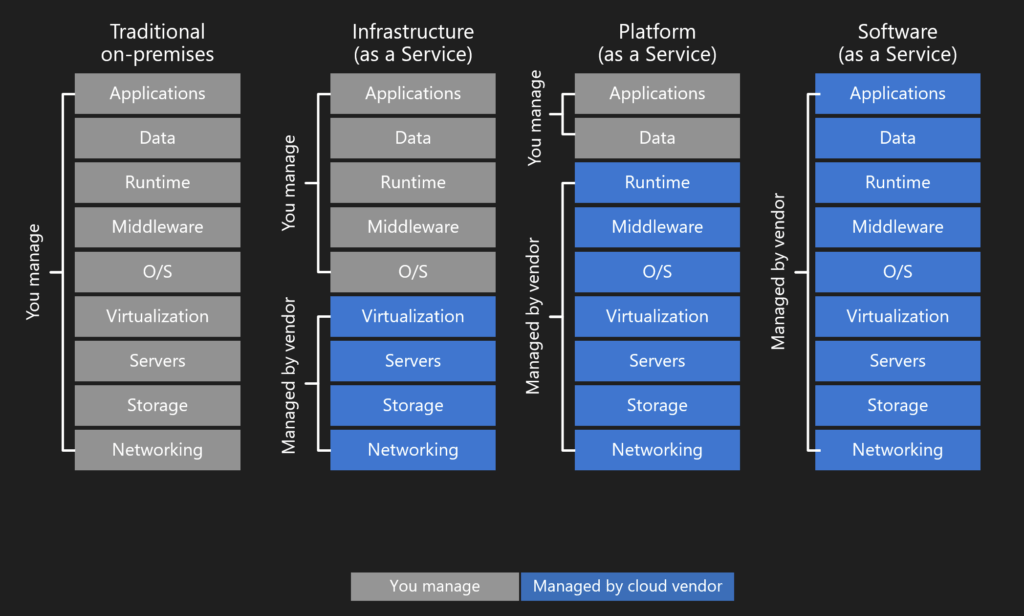As more and more organizations across different industries increasingly embrace cloud computing, they are confronted with critical decisions on adopting the right cloud strategy. The cloud offers various deployment models, each catering to specific business needs and objectives.
In previous articles, we explored the benefits of migrating to the public cloud and addressed common challenges during that cloud migration process. This article aims to go deeper into four main cloud deployment models in order to understand their unique characteristics and advantages, and why PaaS is increasingly becoming the preferred deployment model for organizations aiming for long-term cloud adoption.

Understanding (I)(P)(S)aaS
Infrastructure-as-a-Service (IaaS) allows organizations to lift and shift their existing on-premises applications and infrastructure to the cloud. While it offers the full flexibility of the cloud, it does require organizations to continue to manage their infrastructure and operations systems and will require technical expertise for tasks like patching, configuration, and maintenance.
With Platform-as-a-Service (PaaS) the need to manage the underlying infrastructure is removed, allowing organizations to rely on the managed offerings of the cloud fully. This strategy allows organizations to solely focus on managing their applications and data, enhancing overall efficiency.
A further level of abstraction is Software-as-a-Service (SaaS), typically standard, production-ready solutions. Quite often these solutions focus on a specific vertical and are developed with end-users in mind. These kinds of services offer the least amount of control, you can tweak some settings, but the provider handles all aspects of the software.

Embracing PaaS in your cloud adoption strategy
As we previously touched on in this series, a lift-and-shift strategy (IaaS) can be a good first step toward cloud adoption, however, it can result in missed opportunities for optimizing your business workloads for the cloud.
While lift-and-shift typically offers a quick migration path, it often leads to suboptimal utilization of resources and therefore falls short of optimizing organizations' cloud costs. Organizations may end up paying for overprovisioned resources and missing out on the potential cost saving when the workload would have been optimized for the cloud.

IaaS should be viewed as a temporary step, enabling organizations to start their cloud journey, but the ultimate goal should be to transition towards a more PaaS-centric architecture and vision. While it provides flexibility and has the same familiarity as traditional hosting, IaaS is not leveraging the full potential of the cloud.
By adopting PaaS and other cloud-native approaches, organizations can focus on delivering business value and solutions. Allowing them to leverage the full potential of the cloud, ensuring cost efficiency, innovation, scalability, and improved security. PaaS acts as a catalyst for digital transformation, enabling faster time-to-market for new features and updates in today's competitive landscape. It forces organizations to rethink their application design and approaches, gaining that competitive edge that sets organizations apart in an ever-evolving digital landscape.
Balancing capabilities with a hybrid adoption strategy
All in all, this doesn't mean organizations have to embark on a full-scale cloud migration journey. A lot of them have significant investments in on-premises infrastructure and some technical and regulatory challenges may arise during a cloud migration process. In all honestly, even some components or processes might not be suitable for immediate cloud migration at all.
It's essential to adopt a strategy that involves evaluating which workloads, applications, or data can benefit most from the advantages the cloud brings. By selectively moving certain workloads or applications to the public cloud, organizations can improve scalability, cost-efficiency, and innovation while keeping sensitive or complex workloads in their private infrastructure.
This hybrid cloud approach provides a practical solution to find a correct balance between utilizing existing investments and embracing the cloud's potential. This gradual approach makes sense for a lot of organizations, allowing them to gradually modernize their operations while mitigating risks and ensuring a smooth transition towards full cloud adoption.

Conclusion
The cloud offers a full spectrum of deployment models, each of them specific to certain business needs and goals. As more and more organizations embark on their cloud journey, choosing the right cloud adoption strategy is key.
During this article, we've unraveled the potential of IaaS, PaaS, and Saas. While IaaS provides certain flexibility, it may only be a temporary solution as organizations seek to fully leverage the potential public cloud brings with a PaaS-centric approach. With PaaS, organizations eliminate the need to manage underlying infrastructure and can focus solely on delivering business value.
However, adopting a certain cloud strategy doesn't have to be an all-or-nothing story. By choosing a hybrid cloud approach, organizations can evaluate which workloads and applications are best suited for the cloud and take into account certain technical and regulatory constraints. This strategic balance between on-premises and cloud resources enables organizations to modernize their operations gradually, ensuring a smooth and risk-mitigated transition toward full cloud adoption.
Finding the correct cloud adoption strategy is key for organizations in today's competitive business landscape. Embracing the cloud with a well-informed and fit-for-purpose architecture and strategy empowers organizations to stay at the edge of innovation and meet the ever-evolving demands of digital transformation.
We are here to help because the hardest problems are solved together. Read more about our Services and let’s do amazing things, together!



